The intelligent, athletic, and loyal Goldendoodle is a cross between a Standard Poodle and Golden Retriever, which both have very different shedding traits.
On the one hand, Poodles shed so little that they are often referred to as “non-shedding.” And on the other hand, Golden Retrievers are considered moderate-to-heavy shedders.
Where does that leave the Goldendoodle?
Goldendoodles will typically shed less than a purebred Golden Retriever, and they can be more tolerable for allergy sufferers, which is partly why they’ve become such a popular “designer” breed. However, Goldendoodles will typically shed more than a purebred Poodle.
As for exactly how much shedding you should expect… that depends largely on genetics, but generally speaking, the more Poodle in the Goldendoodle’s genes, the lower the shedding is likely to be. You can also get smaller varieties, like the Miniature Goldendoodle, which can further reduce the overall shedding since the dog has less hair to lose than a larger dog.
To sum it up, if you’re looking for the lowest-shedding, most “hypoallergenic” variety of Goldendoodle, that’d be a Miniature F1BB Goldendoodle because that’s the smallest type of Goldendoodle and has mostly Poodle genes (87.5% Poodle, 12.5% Golden Retriever).
However, it’s also worth noting that the more Poodle your Goldendoodle has in its lineage, the higher maintenance they’re likely to be when it comes to grooming. So it’s a tradeoff.
In this post, I’ll show you what you need to know about Goldendoodle shedding, how to know which Goldendoodles shed the least, and discuss what they’re like to groom.
So if you’re thinking about adopting a Goldendoodle, read on!
How Much Do Goldendoodles Shed?
The amount of hair a Goldendoodle sheds will depend mostly on its genes. This is because, unlike a purebred dog, designer breeds (aka cross breeds) inherit traits from two different breeds. In this case, the Poodle and the Golden Retriever.
On the one hand, Poodles shed virtually no hair at all. And this, among other reasons, is why there are so many popular “doodle” type designer dogs.
In contrast, however, Golden Retrievers are considered moderate-to-heavy shedding dogs. Goldens are also double-coated, meaning they have an undercoat and an outer coat. And while they typically shed moderately year-round, this can increase for several weeks during spring and fall as they shed their undercoat (aka “blow coat”). This is known as seasonal shedding, and it occurs as the Golden naturally prepares for changing weather conditions.
So, the best way to know how much a Goldendoodle is likely to shed is to consider its genetics, and the best way to know that is to either get a DNA test or speak with your breeder.
But to help give you an idea of what to expect, let’s look at the different genetic categories of a Goldendoodle (i.e., F1, F1B, F1BB, and F2) and the different breed sizes. Then, I’ll show you how to spot the difference in case you’re not sure what genes it has.
Poodle & Golden Retriever Genetics (F1, F1B, F1BB, & F2)
One of the things you’ll find when researching designer dogs like the Goldendoodle is that there are all of these weird “F1” and “F1B” terms people throw around to describe the breed.
But what do these terms mean? And how do they relate to shedding?
In short, these terms are used to describe the genetics of a cross-breed dog, and the following points will show you how much each variety is likely to shed:
- F1 Goldendoodle (low-to-moderate shedding): The F1 Goldendoodle means that it’s 50% Poodle and 50% Golden Retriever. With this variety, you are likely to experience low-to-moderate shedding and potentially some level of seasonal shedding if your Goldendoodle has an undercoat.
- F1B Goldendoodle (low shedding): An F1B Goldendoodle is the result of crossing an F1 Goldendoodle with a Poodle, which makes it 75% Poodle and 25% Golden Retriever. This variety is generally considered low shedding.
- F1BB Goldendoodle (very low shedding): The F1BB Goldendoodle is 87.5% Poodle and only 12.5% Golden Retriever. And because this variety is predominately Poodle, it’s considered to be the lowest shedding type of Goldendoodle.
There are other variations of Goldendoodle, but those are the main ones worth mentioning. I say that because breeding beyond an F1BB is getting to the point where you might as well get a purebred Poodle. And while there’s such a thing as an F2 Goldendoodle, those are virtually the same as an F1 because they are the result of crossing two F1 Goldendoodles (so you end up with a 50/50 Poodle x Golden Retriever anyway).
Nevertheless, with that out of the way, another factor to consider is how big your Goldendoodle is likely to be since this can impact the amount of hair you notice around the home.
So let’s discuss the different sized Goldendoodles that exist.
Standard, Small, and Miniature Goldendoodles
A dog’s size technically won’t change its rate of shedding. However, smaller dogs have less hair to drop in the first place compared to larger dogs. So this can be another factor to consider.
And the Goldendoodle typically comes in three main sizes:
- Standard: The Standard Goldendoodle, which is the result of crossing a Standard Poodle with a Golden Retriever, stands 20 to 24 inches tall and weighs between 50 to 90 pounds.
- Small: The Small Goldendoodle is about 17-20 inches tall at the shoulder and weighs 40-50 pounds. This is about midway between a Standard and Miniature Goldendoodle.
- Miniature (aka Teacup): This is the smallest variety of Goldendoodle and is the result of crossing a Miniature or Toy Poodle with a Golden Retriever. A Miniature Goldendoodle is typically between 13 to 20 inches tall from the shoulder to the ground and weighs about 15 to 35 pounds.
Given the Goldendoodle is a designer breed, there is no specific American Kennel Club (AKC) breed standard. But those are the general heights and weights of a Goldendoodle.
How Can You Spot the Lowest Shedding Variety?
As mentioned, the lowest shedding variety of Goldendoodle is the Miniature F1BB Goldendoodle because this is the smallest variety and has mostly Poodle genes. And the most accurate way to know what any Goldendoodle is (in terms of its lineage) would be to get a genetic test done or speak to a reputable breeder before adopting.
That said, there are some tell tail signs that can give you a general indication of how much Poodle and Golden Retriever the dog has in its genes. This is by no means perfect, but it’s one of the quickest and easiest ways to know what you’re working with.
Regarding Poodles, if allowed to grow, they have what’s known as “furnishings” (facial hair) around the eyes and snout, otherwise known as furry eyebrows, mustaches, and goatees. They also have curly or wavy coats, which can be another thing to look for.
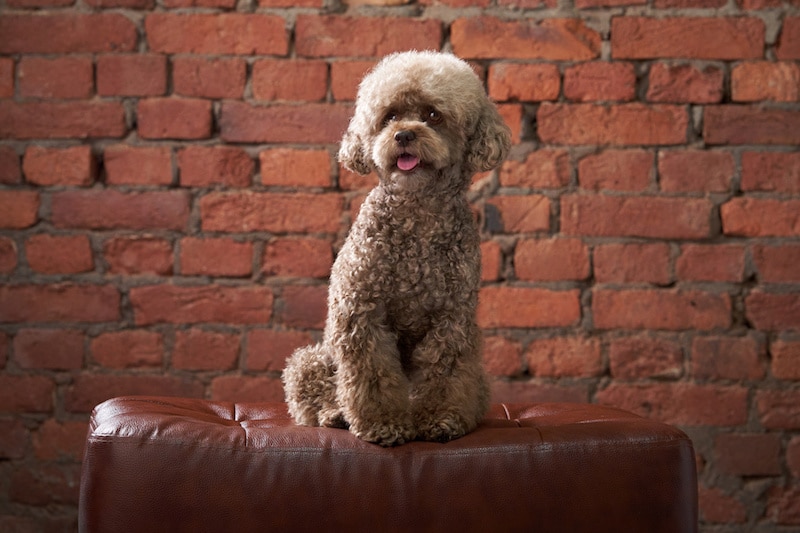
In contrast, Golden Retrievers don’t have facial hair, and their coat is straight. They also have a double coat, so if you part their fur and notice a fluffy, light-colored undercoat, that’s another indication your Goldendoodle is predominately Golden Retriever.
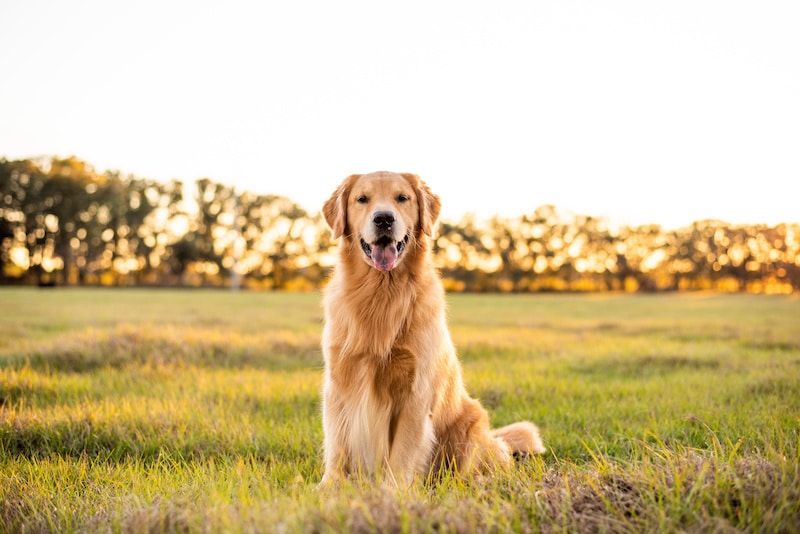
So, if your Goldendoodle looks more like a Poodle, you can typically expect less shedding, but as I’ll now explain, Goldendoodles that are predominately Golden Retriever are easier to groom.
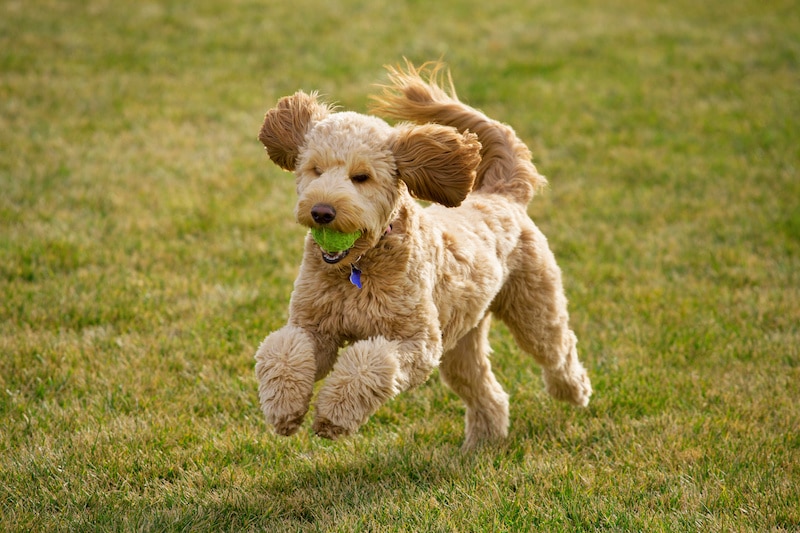
Are Goldendoodles High Maintenance?
Goldendoodles can range from high to low-maintenance dogs depending on their coat, which in turn depends on their genes. But in general, the more Poodle-like your Goldendoodle’s coat is the more time, effort, and money you’re likely to spend on grooming.
And to explain why I say this, let’s compare the difference between a Poodle’s coat and that of a Golden Retriever since they are the Goldendoodle’s parents.
Poodles typically have curly hair that, like humans, grows in perpetuity. Not only are curly coats prone to mats, tangles, and knots, but they can get debris trapped in them fairly easily. And because the hair keeps on growing, it needs to be trimmed to keep it orderly.
Golden Retrievers, on the other hand, have straight, medium-length coats. As such, brushing them is easy, takes very little time compared to a Poodle, and they don’t require trimming. That said, they do shed more and have an undercoat, which can increase brushing frequency if you want to keep your home and car free of dog hair.
So, if your Goldendoodle is more like a Golden Retriever than a Poodle, their coat is likely to shed more, but it’ll also be easier to maintain.
What sort of brush should you use?
If your Goldendoodle has a Poodle-like coat, a pin brush and/or slicker brush can work well. Or, if your Goldendoodle’s coat resembles more that of a Golden Retriever, a bristle brush is best for everyday brushing, while a de-shedding tool will do a better job of removing loose fur.
What about trimming?
It’s very common to trim a Poodle’s coat, especially when the hair is growing too long around the face. But if your Goldendoodle has an undercoat (like a Golden Retriever), it’s best to avoid trimming too much off because the undercoat helps protect them from the elements, including cold AND hot weather, insects, and sunburn.
Not to mention, trimming won’t reduce shedding anyway. So when it comes to trimming, the most important thing to remember is not to take too much off. And if you’re not sure how much is too much, it may be best to speak to a professional groomer.
Recommended: Go here to see our top-rated dog hair blow dryers
Are Goldendoodles Hypoallergenic?
No, Goldendoodles are not hypoallergenic.
Why? Because first of all, no dog is 100% hypoallergenic. And second, how “hypoallergenic” your Goldendoodle is will depend largely on its genetics.
On the first point, the reason no dog is hypoallergenic is that the main cause of pet allergies isn’t usually the dog’s hair; it’s their dander (dead, flaking skin cells). And since all dogs produce dander, there is technically no such thing as a completely hypoallergenic dog.
That said, some dogs are considered more “hypoallergenic” than others, which is usually because they produce less dander and don’t shed much (which matters since dander sits on old hair). And one of these dogs is the Poodle, which has been designated as hypoallergenic by the AKC.
So, going back to the second point I made earlier, how hypoallergenic a Goldendoodle is will depend on its lineage. As with shedding, the more your Goldendoodle takes after a Poodle, the less likely he is to trigger allergy-related symptoms.
For example, an F1BB Goldendoodle (which is mostly Poodle) will generally be more tolerable among allergy sufferers than an F1 Goldendoodle and a lot more tolerable than a purebred Golden Retriever.
How Can You Reduce Goldendoodle Shedding?
If you are noticing too much loose hair around your home, there are numerous ways you can get this under control, but the most effective approaches relate to diet and grooming.
Diet
An optimal diet can make a huge difference to your dog’s overall health, quality of life, and the condition of his skin and coat. Poor quality dog foods that contain lots of fillers and cheap, artificial ingredients can lead to allergies and excessive shedding, whereas high-quality kibble will give your dog everything needed to thrive.
Not to mention, some dog foods have been formulated to include things like healthy Omega 3 and 6 fatty acids that can nourish your dog’s skin and help prevent excessive molting.
It’s best to speak to your vet before changing your dog’s diet, but you can see our top dog food picks if you want to know more about dog foods that can help reduce shedding.
Grooming
Once you’re confident that your dog’s diet is optimal, another tool in your shedding arsenal is grooming. Not only can daily brushing help reduce the occurrence of mats if your Goldendoodle has long, curly hair, but it can help prevent excess shedding by helping to spread his natural skin oils and remove the dead hair that is already on the coat.
So, brushing can be a very worthwhile activity.
Aside from that, bathing your dog every month or two can help you remove a lot of excess old hair, especially when you combine this with a good blow dry and brush.
You don’t need to use a blower, but if you do, it’s best to use a proper dog hair blow dryer or one that isn’t too hot. It’s also worth using a shampoo designed for dogs, as harsh shampoos can dry out your dog’s skin and cause irritation, which in turn can lead to more shedding.
There are other ways you can reduce shedding, but those are the approaches that tend to work well in most cases. In some cases, however, dogs can shed due to health reasons like allergies, fleas, and even disease, for example. So if you’re concerned about your dog’s hair loss, for any reason, it might be worth a trip to the vet.
Related Questions
- Do Goldendoodles shed more in summer or winter?
- Are Goldendoodles lower shedders than Labradoodles?
- Do Goldendoodles shed their puppy coat?
- What color coats do Goldendoodles have?
- Do Goldendoodles smell?
- Do Goldendoodles bark a lot?
- What are Goldendoodles like?
Do Goldendoodles shed more in summer or winter?
If your Goldendoodle takes more after a Golden Retriever, you may notice an uptick in shedding during spring and fall (autumn) for several weeks as he prepares for the changing seasons.
In spring, Golden Retrievers usually shed the thick double coats that helped them keep warm in winter in preparation for the coming summer months. And during fall, they tend to shed their lighter summer coats in preparation for winter.
Outside of that, the shedding should be fairly even year-round.
Are Goldendoodles lower shedders than Labradoodles?
All else being equal, Goldendoodles and Labradoodles shed about the same amount of hair because Labradors and Golden Retrievers shed about the same.
That said, there can be huge differences in shedding between any one Goldendoodle or Labradoodle based on their specific genes.
For example, an F1 Goldendoodle is likely to shed more than an F1B Labradoodle, which itself will typically shed more than an F1BB Goldendoodle.
So it’s not so much whether it’s a Labradoodle or Goldendoodle that determines shedding; it’s what percentage of Poodle either cross breed has in its genes.
Also, there are numerous other factors that can contribute to shedding in general, such as diet, allergies, and other health-related reasons. So even with everything I’ve said in mind, there can still be differences between individual dogs.
Do Goldendoodles shed their puppy coat?
Most dogs shed their puppy coat, and the Goldendoodle is no exception. It’s difficult to predict exactly when it’ll happen, but most Goldendoodles shed their puppy coat at around six months of age, which is generally replaced by a thicker, stronger coat.
What color coats do Goldendoodles have?
The most common color for a Goldendoodle is gold, but they can also be black, apricot, cream, copper, gray, white, or red.
Do Goldendoodles smell?
Goldendoodles are typically low-odor dogs, but as with any dog, they can smell at times. How smelly they get and how often will vary depending on factors like your local climate, how active your Goldendoodle is, and how often you bathe him, among other things.
Do Goldendoodles bark a lot?
Goldendoodles are generally not heavy barkers. However, if you are noticing excessive barking for everyday things like people walking past on the street, it may be worth getting behavioral training to help get this under control. And in that case, the earlier you do that, the better.
What are Goldendoodles like?
Goldendoodles are known for their intelligence, athleticism, and loyalty. They are also known to love human companionship and be very friendly and affectionate.
So if you’re looking for the ideal family dog that sheds less than a Golden Retriever, the Goldendoodle could be just the breed you’ve been looking for.
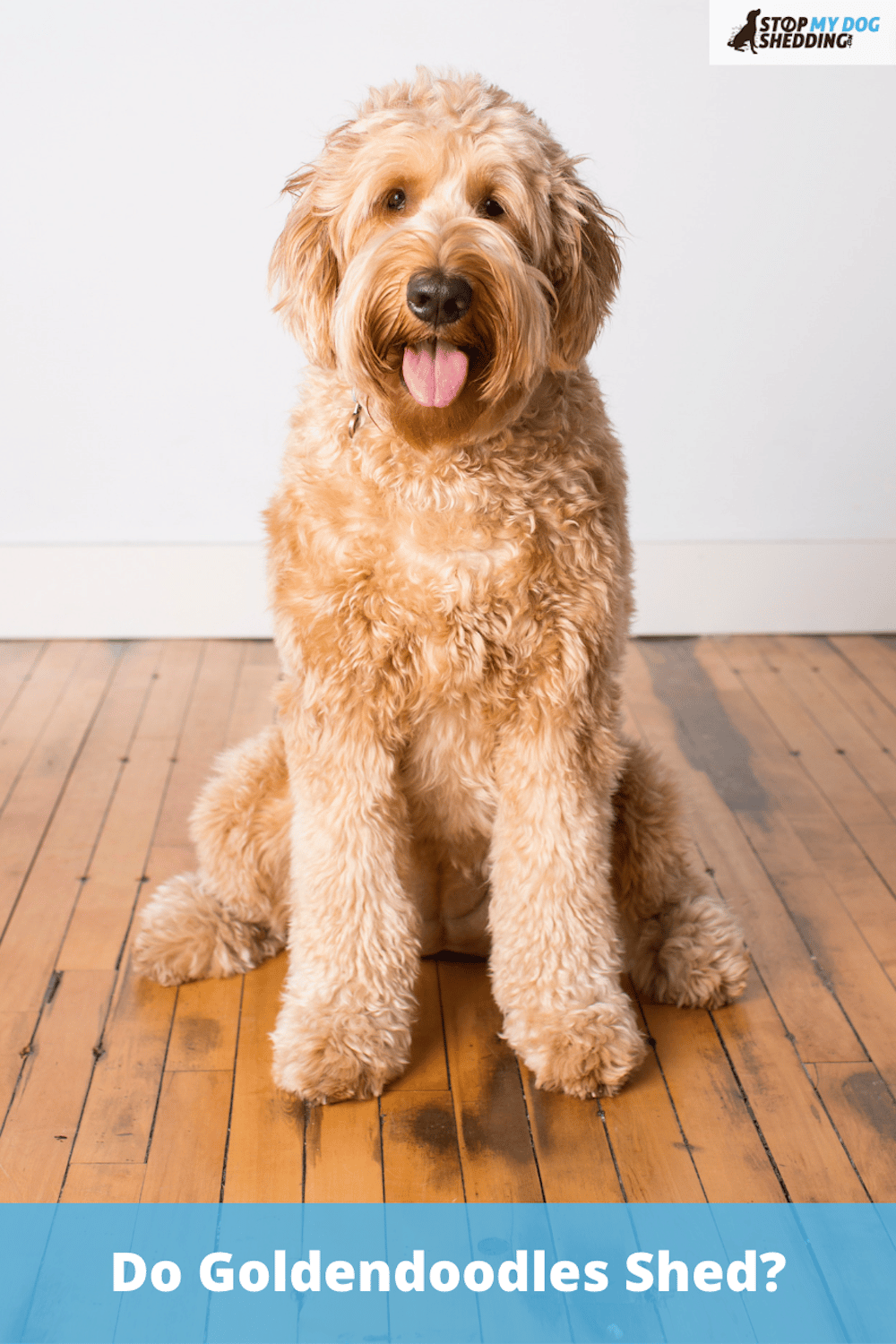

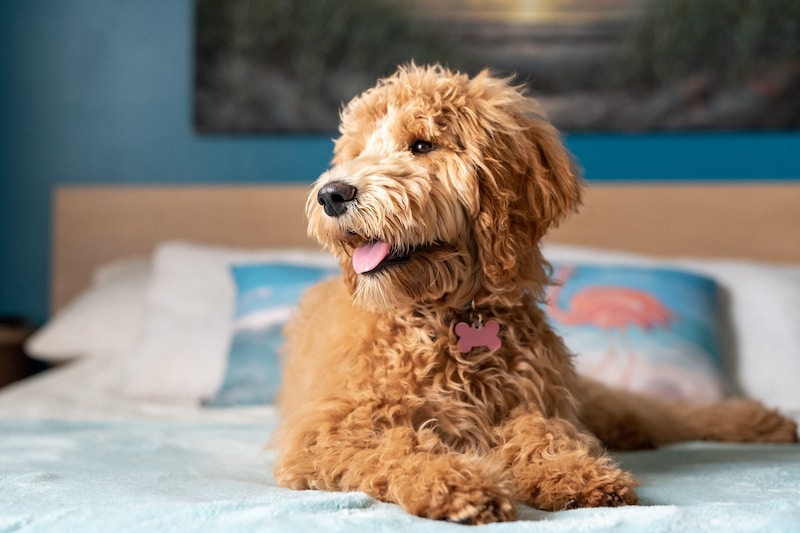










Please note: By submitting a comment using the above comment form, you confirm that you agree with the storage and handling of your data by this site as detailed in our Privacy Policy.